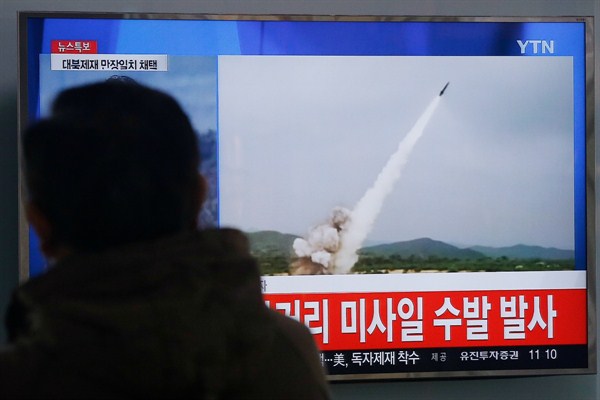THAAD and other missile defense systems offer clear military advantages for countries that deploy them—but they could alter longstanding and delicate political balances.
Missile defense has become an increasingly important focus of security policy around the world. On the Korean Peninsula, North Korea’s provocative missile tests have led Seoul to move toward deploying U.S. Terminal High Altitude Area Defense (THAAD) anti-missile batteries, despite opposition from China. Proponents argue that THAAD deployment in South Korea is necessary to meet the evolving challenges posed by the North’s arsenal of short- and medium-range missiles. U.S. forces in South Korea face limits with Patriot Advanced Capability (PAC) batteries, which only target missiles during their final descent and lack THAAD’s ability to intercept missiles at a higher altitude. Critics, on the other hand, argue that the benefits of THAAD are limited and that it would be unable to fend off a massive attack from the North.
To learn more about THAAD deployment in South Korea, read North Korea’s Provocations Revive U.S. Missile Shield in South Korea for FREE with your subscription to World Politics Review.
An Integrated Missile Defense System for the Persian Gulf?
Far from the Korean peninsula, the U.S. has also pushed its Persian Gulf partners to deploy an integrated missile defense system to counter the ballistic missile capabilities of Iran, as well as non-state terrorist organizations. Cooperative and integrated THAAD and Patriot missile defenses would be more effective than discrete individual systems in each country, allowing Gulf states to share sensors and avert inadequate coverage against ballistic missiles. However many of the impediments to past Gulf state missile defense cooperation remain potent, and previous efforts toward this end have yielded minimal progress.
To learn more about U.S. missile defense strategy in the Persian Gulf, read U.S. Pushes Missile Defense to Reassure Gulf Partners for FREE with your subscription to World Politics Review.
[marketing]ofie[/marketing]
Are U.S. Plans for Missile Defense Triggering a New Nuclear Arms Race?
Last March, during his annual speech to the nation, Russian President Vladimir Putin made headlines around the world when he unveiled a raft of new and exotic military weapons systems that were in development, and in some cases ready to be deployed. Putin’s inventory included new maneuverable re-entry vehicles that will, in theory, be fitted onto Russian ballistic missiles to help them overwhelm American missile defenses, and a nuclear-powered cruise missile apparently able to fly for thousands of miles just feet above the surface of the earth that would also render U.S. missile defenses useless. Russia has long had an obsession with ballistic missile defense, from former President Ronald Reagan’s futuristic Strategic Defense Initiative in the 1980s to then-President George W. Bush’s decision to abrogate the Anti-Ballistic Missile Treaty in 2002, when Putin was serving his first term as president. Put simply, the Russian leadership has never been able to shift the perception that American ballistic missile plans are aimed squarely at them and at achieving a lasting strategic advantage.
To learn more about how Russia is responding to U.S. plans for missile defense, read Putin and Trump Ratchet Up the Risks of a New Nuclear Arms Race for FREE with your subscription to World Politics Review.
The Global Race for Missile Defense Technology
The U.S. and its allies are not alone in pursuing anti-missile defenses, even if they often take pains to mask those efforts. In March, for instance, Indian Prime Minister Narendra Modi took to the airwaves to make a dramatic announcement: India had successfully shot down one of its own satellites in low-Earth orbit with a missile. Only three other countries have demonstrated that capability: Russia, China and the United States. “India stands tall as a space power,” Modi declared, noting that the technology had been developed indigenously. Modi’s glee at this demonstration of his country’s technological prowess was not shared by many space experts, who caution that the debris created by the missile test poses a threat to other satellites and spacecraft orbiting Earth. What’s more, regional analysts noted that for India, the test actually had little to do with its space program. It was more likely intended as a demonstration of India’s ability to shoot down an incoming ballistic missile, even if its effectiveness in that regard was limited.
To learn more about how the U.S. is not alone in pursuing missile defense technology, read India’s Anti-Satellite Missile Test Underscores the Need for a New Space Treaty for FREE with your subscription to World Politics Review.
[marketing]ofie[/marketing]
You can learn all about THAAD and a wide variety of other global issues in the vast, searchable library of World Politics Review (WPR):
- The strategy behind THAAD deployment in South Korea, in North Korea’s Provocations Revive U.S. Missile Shield in South Korea
- The limitations of THAAD, and China’s objections to it, in What the THAAD Missile Defense System Can – and Can’t – Do in South Korea
- U.S. missile defense strategy for the Gulf states, in U.S. Pushes Missile Defense to Reassure Gulf Partners
- How Russia is responding to U.S. plans for missile defense, in Putin and Trump Ratchet Up the Risk of a New Nuclear Arms Race
- How India’s ASAT testmasked a missile defense test, in India’s Anti-Satellite Missile Test Underscores the Need for a New Space Treaty
[marketing]boilerplate[/marketing]
Editor’s Note: This article was first published in July 2018 and is regularly updated.India’s

